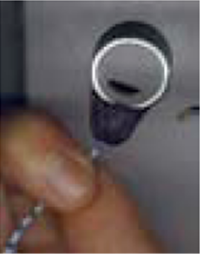Table of Contents
Solenoids
Solenoids are simple and cheap linear actuators that are widely used in the construction of contactors, circuit breakers, and solenoid valves. The majority of the solenoids generate force only in one direction and they are used as on-off actuators
Introduction
A solenoid consists of a coil and a moving metal rod, also known as armature or plunger. The operation of solenoids is based on conversion of electrical energy into mechanical energy, and therefore solenoids are being considered as electromechanical actuators. Normally, the coil is a copper wire wound with a tiny pitch and placed in a metal (iron-based material) case, also known as a C-frame. The C-frame is a supporting structure that also contributes to the magnetic field produced by the coil. Applying an electrical current to a solenoid coil generates a magnetic field or flux with intensity proportional to the current. The magnetic field pulls the plunger in. The reason for the plunger attraction is a ferromagnetic material with high magnetic permeability, whereas air which has very low magnetic permeability. Pulling the plunger inside closes the air gap and intensifies the field concentration inside the solenoid 1).
The plunger (armature) of the solenoid can only be attracted by the magnetic field, hence the solenoids can only generate force in one direction. Normally when the solenoid is in rest the plunger is kept far from the coil using a spring. However, solenoids have been used as servo actuator in engine mount application. Arzanpour and Golnaraghi 2) have replaced the plunger of a solenoid with a permanent magnet and retrofitted it inside an active engine bushing. It enables them to both attract and repel the actuator and create sinusoidal motion with it. Also Mansour et. al. 3) have replaced the spring of a solenoid with a stronger one and gave the solenoid a bias current to use it as a servo actuator.
Equations
The mathematical behavious of a solenoid is extremely non-linear. The induced magnetic force on the plunger is given by
in which
where xs , is the plunger motion, is , is the electrical current in the coil, Fs , is the static magnetic force applied to the plunger, N is the number of the coil turns, μ0 is the permeability coefficient of the air, and μc and μp are the permeability coefficient of the core and the armature. Ae is the effective cross section area through which the magnetic flux is flowing. This non-linear behaviour is illustrated in the below figure. Although it's not precise the behaviour of the solenoid can be approximated by a linear system close to each equilibrium point.
Applications
Solenoids are simple, robust, low-cost, relatively powerful, and capable of working in harsh environments. On the other hand, they are hard to control and do not have enough flexibility for most of the applications. Marshal's thesis 5) has a chapter that compares different vibrotactile feedback devices among which there is one solenoid actuator. Below is his conclusion on the mentioned actuator (although it can be hardly generalized to all solenoids)
Göbel et. al. 8) have placed a solenoids on the side of a mouse for vibrotactile feedback. Also Bongers 9) used solenoids in making the Tactile ring. The Tactile Ring (shown below) consists of a small aluminum ring, which can be worn around the tip of the finger. This actuator is made from a small relay coil, which drives a pin with a diameter of 1 mm against the skin of the fingertip. The Tactile Ring (Bongers, 1997) has been successfully used to add tactile feedback to a number of instruments, including the LaserBass and the SonoGlove.






